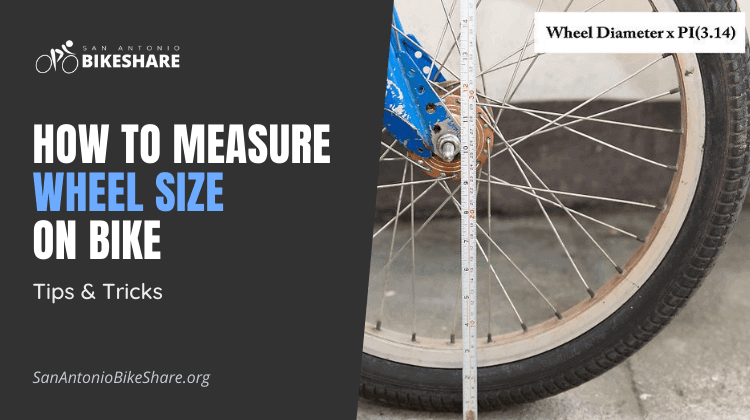How to Measure Wheel Size on Bike – Tips & Tricks
Do you know how to measure wheel size on bike? If you wish to buy a replacement or spare tire for your bicycle, you must first know about the measuring wheel size on a bike.
Knowing your bike’s wheel size is essential for bike ownership and maintenance. For optimal fit, many accessories require this information. The diameter of your bike wheel can be measured in two ways. Fortunately, both are easy to understand.
Read this article to understand how to determine wheel size on bike.
The ISO Method for Measuring a Wheel
The ISO method, or International Organization for Standardization, allows you to determine a bike’s wheel size in metric measurements, particularly millimeters (mm). The most dependable and best method for measuring your tires at home is ISO sizing. This approach requires only a few simple steps for measuring wheel size on a bike.
1. Get a Metric Units Measuring Tape first
If you don’t have a millimeter ruler, you can convert inches to millimeters by multiplying the measurement in inches by 25.4.
2. Take a measurement from the center of the wheel to the inside edge of the tire
Multiply the length by two to determine the diameter. The diameter of the wheel measured from the bottom of the channel on the rim where the tire bead fits is known as bead seat diameter (BSD). It’s tough to tell with a tire on, but it’s normally 10-12 mm smaller than the wheel diameter.
3. Measure the width of the wheel across the flat area of the tread on the tire
Keep in mind that different width tires might be used on the same wheel; thus, this measurement may not be exact. If you have a bike wheel rim without a tire, you can measure the inner rim width, which is the distance between the two inner sides of the channel on the rim where the tire will sit.
4. In millimeters, list the breadth first, followed by the diameter
For example, a bike with a width of 39 mm and a diameter of 700 mm would be 39 mm wide and 700 mm in diameter. Keep in mind that while looking at ISO-defined dimensions, a BSD may also be offered. The BSD can be stated as a value separated by a hyphen after the width or as a value separated by a cross before the width (x).
Also Read: Best Road Bike Tires | Reviews & Buying Guide
Measuring a Wheel Using the Standard Method
The most common way for measuring wheel size on a bike is to determine in inches (in). This strategy is straightforward and, like the ISO method, consists of only a few steps:
1. Using a tape measure, measure the distance in inches from the ground beneath the tire to its center point. Multiply this measurement by two to get the diameter
2. Measure from one side of the tire to the other across the flat area of the tread. This, too, depends on the sort of tire you have on your wheel
3. First, write down the diameter, then the width in inches. When purchasing or replacing a tire or other bike accessories, keep in mind that the diameter comes first, followed by the width. For example, the size 26 in x 1.75 in denotes a wheel with a diameter of 26 in and a width of 1.75 in.
Also Read: Best Road Bike Tires for Puncture Resistance | Reviews & Buying Guide
Calculating the Circumference of a Bicycle Wheel
If you intend to use an odometer, speedometer, or GPS on your bike, you’ll need the wheel circumference for proper calibration. You can measure the circumference in a variety of ways, depending on your materials.
One of the simplest ways to measure circumference is with a string. Wrap it evenly around the outside edge of the tire and mark or cut it when it returns to its starting point. By measuring the length of the thread, the circumference of the wheel, including the tire, may be estimated.
You can also use a dot of wet paint to measure the circumference of your wheel. Put a dot of wet paint on a tire’s tread. For at least two revolutions, push the bicycle in a straight line, and the paint should mark the ground twice. To determine the wheel circumference, including the tire, measure the distance between the first and second spots of paint on the ground.
You may easily compute the circumference of the wheel by multiplying the diameter by Pi (3.14). This method is one of a kind in that it may be used to calculate the circumference of a wheel rim without using a tire. To find the answer, multiply the diameter of the rim (from the point where it meets the tire) by Pi. This calculation will give you the circumference of the wheel without taking the tire size into account.
Finally, if you know the wheel width and diameter and have determined the wheel size of a bike using one of the methods above, you may be able to determine the circumference on internet charts.
Also Read: Best Single Speed Wheelset | Reviews & Buying Guide
Bike Wheel Size Determination Tips & Tricks
While determining a bike’s wheel size is simple, there are a few elements that can make it even easier.
Use a kickstand or lean your bike against a wall to keep it from falling over while you work. If you simply need to measure the bike, a retractable metal tape measure is more robust and handy than a flexible tape measure.
If you include the tire in your measurements, make sure you inflate it to the specified pounds per square inch (PSI). On the sidewall of the tire, the appropriate tire pressure should be printed. Finally, check the sidewalls of your tires to see if the measurements you need are listed.
Conclusion
Have you gotten your answer on how to measure wheel size on bike? With the help of extensive research, this article has provided you with numerous possibilities for you to choose from, whichever seems the most suitable to you.
Let’s go biking!







